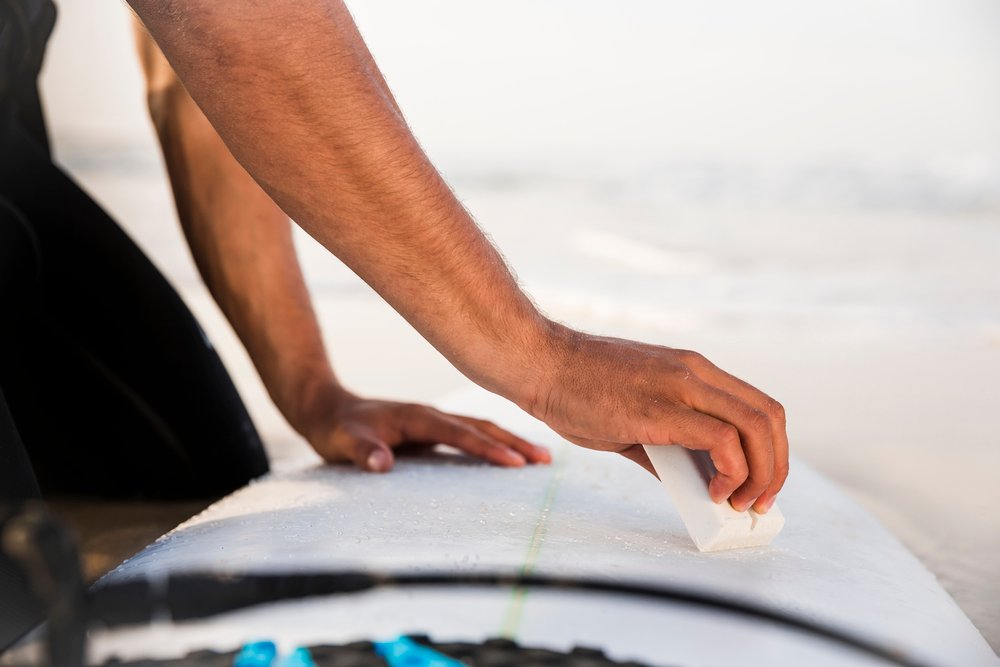If surfing is your newfound hobby, one of the first things you should learn is how to keep your surfboard in mint condition. One method is to use surfboard wax, an emollient primarily made with paraffin wax, beeswax, and petroleum jelly.
5 Reasons To Wax Your Surfboard
So, what's the big deal with surfboard wax, and why should you include its application in your routine? The reasons surfers apply surfboard wax on their surfboards at least every 2 to 3 months, depending on how frequently they hit the waves, are listed below.
1. For traction
Surfboards are mostly made of polyester resin, which makes them extremely slippery when wet. You may already be aware that surfboards do not come with built-in traction pads, making balancing difficult.
Here's where surfboard wax comes in handy. Surfboard wax is a sticky material that provides temporary traction to help surfers stay on their surfboards.
A surfwax is an essential item in any surfer's equipment, whether professional or non-professional, and most especially for amateur surfers. It is a tool that allows surfers to dance around enormous waves without worry of losing their balance. Surfwax gives the foot a firm grip on the surfboard.
2. Different wax for different temperatures
The locality of where you would be surfing determines the type of surfboard wax you should use. Wax that is meant for colder temperatures may melt easily when you use it while surfing in a tropical climate.
As traction is so important to prevent you from slipping, using the right wax for a particular place will give you a better grip on the surfboard. There are 4 types of waxes depending on the water temperature, namely, cold, cool, warm, and tropical.
Cold water waxes are softer in consistency compared to tropical waxes since colder temperatures make the wax harden easily causing it to be more slippery.
3. Maneuverability
A well-waxed surfboard with perfect, sticky bumps will ensure that your feet will have a firm grip making for better maneuvers when tackling a wave. It is easy to lose your balance in the waves, and returning to equilibrium is the key to taking control of the board.
4. Increased confidence
When you are lining up to wait for a wave, the last thing that should be on your mind is whether or not you will slip when it is time to tackle a wave. Applying surfboard wax will give you more confidence that this will never occur and will allow you to enjoy riding the wave more rather than worrying about slipping.
5. For surfboard protection and longevity
The surfboard wax also protects against natural elements such as sea salt and strong winds. These elements naturally deteriorate the surfboard's surface. This is why surfers use surfboard wax, not just to improve grip and traction, but also to extend the life of their surfboards.
How to apply wax on a surfboard
Step 1: Prep your board
Before applying wax, make sure the surfboard is clean. For new surfboards, simply wipe the surface with a cloth to remove any debris. For used surfboards, scrape away old wax by using a wax comb.
It is much easier to remove wax when the board is warmed up either through direct sunlight or a hair dryer on a low setting. Boards need re-waxing if you feel the traction has decreased.
Step 2: Choose the right wax
The temperature of the water is the first to consider when choosing the right wax. Soft wax is the right choice when surfing on cold waters, while harder waxes which melt slower, are used for warmer waters.
Step 3: Application of the base coat
Surfers have a number of methods by which they apply the surfboard wax. Most prefer the cross-hatch pattern, where wax is applied diagonally, creating a crisscross pattern. Others would rub the wax in circular patterns, while some would apply it freestyle.
The goal is to create bumps on the deck surface, which increases the grip of their feet on the surfboard, making it easier to control or change directions while riding a wave.
Step 4: Apply the topcoat
The topcoat prevents the base coat from rubbing off easily. It is softer than the base coat but is also temperature-sensitive. Only a thin coat is necessary to apply the topcoat.
What Makes Surfboard Wax Sticky?
As previously stated, the primary constituents in surfboard wax are paraffin wax, beeswax, and petroleum jelly.
The paraffin wax is derived from crude oil, giving the surfboard wax a tough feel.
Beeswax is extracted from beehives, which are naturally generated by honeybees. This wax improves the pliability of the surfwax and helps to provide a good grip in cold water temperatures.
The petroleum jelly functions as a strong adhesive, ensuring that the surfboard wax remains solid regardless of how powerful the waves are.
These three key ingredients combine to create a surfboard wax that provides surfers with the traction and grip they require while surfing.
How To Properly Store Your Surfboard Wax
Now that you are already aware of the important uses of surfboard wax, the next you need to know is how to store it correctly. Don’t just leave it anywhere, more so in a place where there is direct sun exposure, lest you’d see it melt away.
Instead, keep your surfboard wax dry and out of direct sunlight. And, as a last tip, make sure that your surfboard wax does not get covered with sand.
Final Thoughts
Maintaining good balance is key whenever you are riding a wave, and applying wax on your surfboard is one of the most crucial things you can do to achieve this. The surfboard, whether it is made from foam, wood, or polyurethane, is slippery when wet, and surfboard wax increases the traction of your feet.
Learning how to apply surfboard wax properly is one of the basic things you will learn to do as you embark on this fun sport. This will not only ensure safety for you and other surfers but will also enhance the experience of riding a wave.


